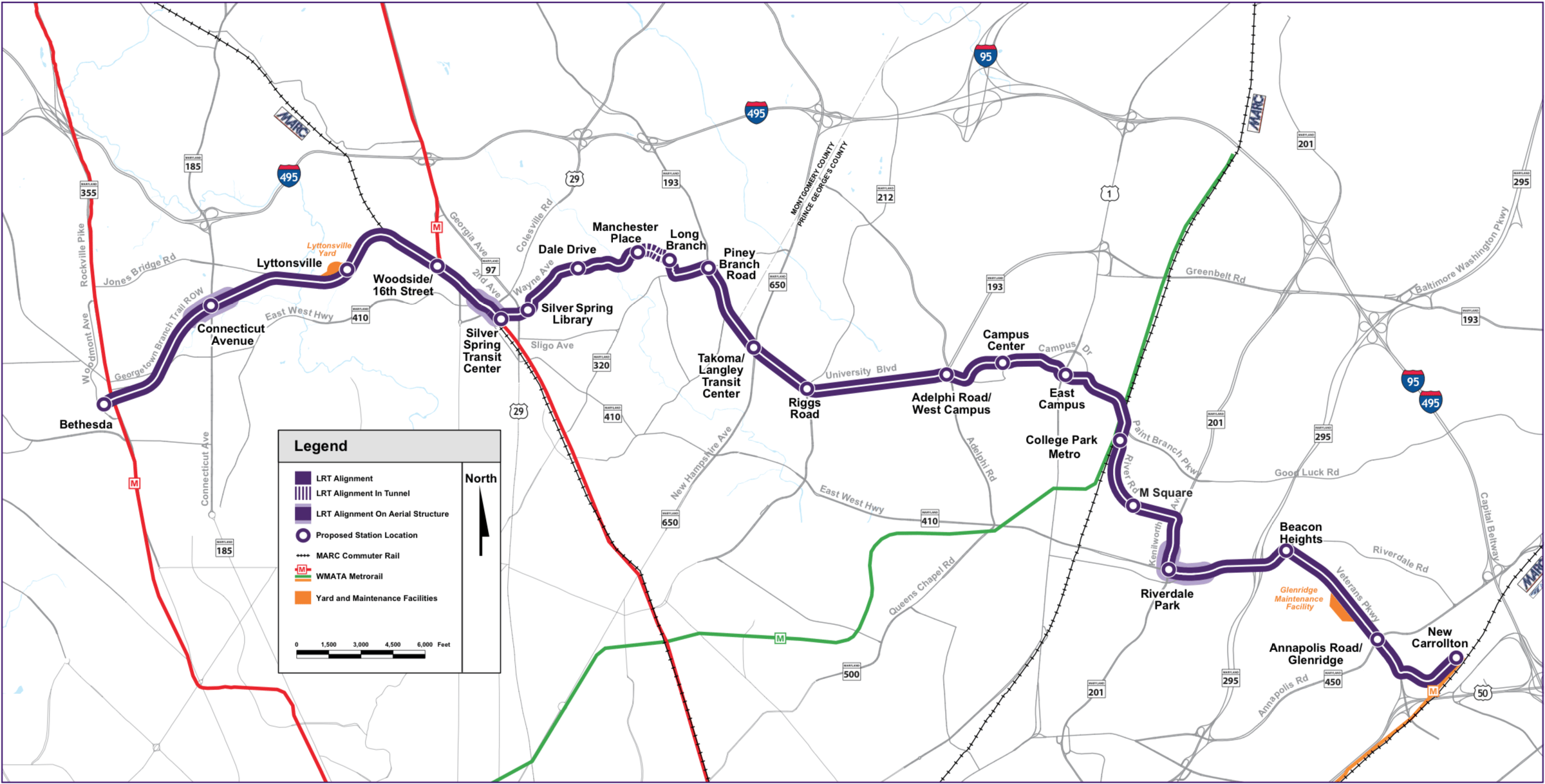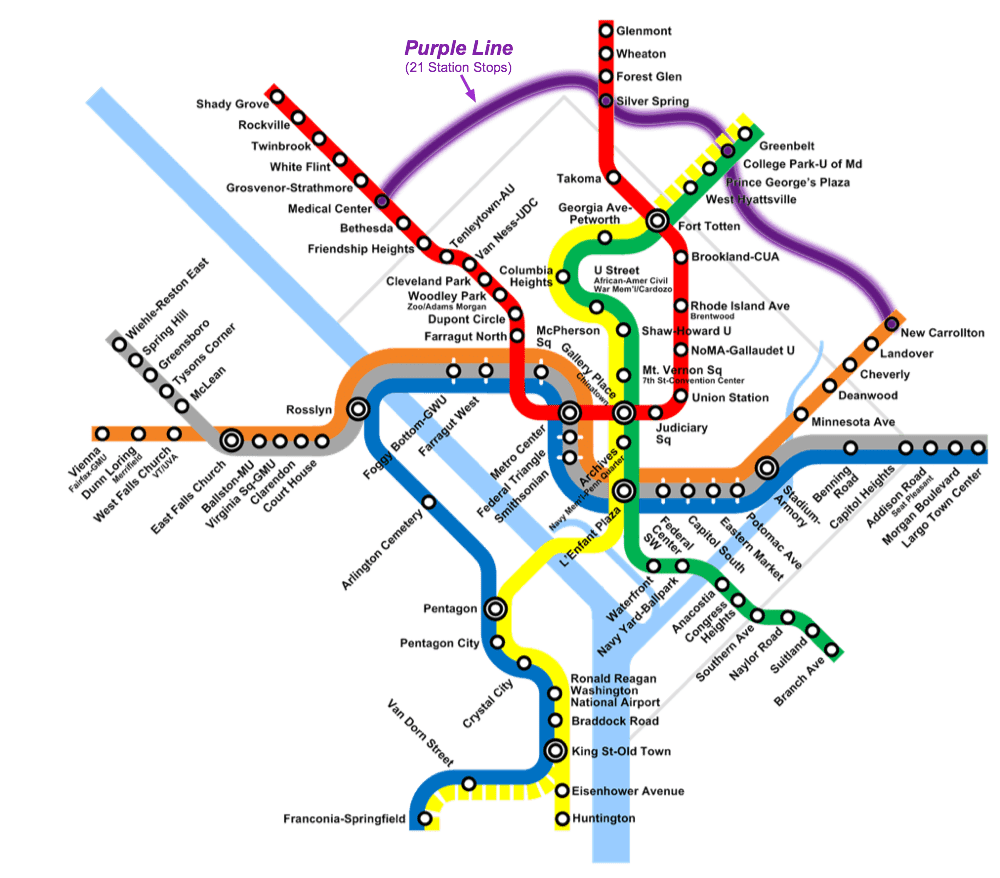Rail IT serving MTA Purple Line – A Public–Private Partnership (PPP) Project
Rail IT has been serving the Purple Line Transit Partners Team since its inception (i.e. beginning of the PLTP proposal development) in March 2014. Primary involvement was Systems concept development, subsystems procurement, systems integration plans, run-time simulations, risk management, subsystems cost estimates, and system-wide lifecycle cost estimates which includes Operations and Maintenance for a 30 years service horizon. Maryland MTA selected the PLTP proposal in 3/2016 with contract award to PLTP in June 2016.
Rail IT continues serving the Purple Line Transit Construction company as well as the Purple Line Transit Operators in design, implementation, test/integration, and operations & maintenance. Significant responsibilities include concept and design development including design reviews and verification of the following LRT systems:
- Train Control System
- Central Control System
- Supervisory Control and Data Acquisition Systems
- Traction Power Management and Energy Management control systems
- Overhead Contact System
- Communications Subsystems (Backbone, Network, Security, Fire Management, etc.)
- Tunnel Ventilation and Fire Emergency Management Systems
- Vehicle onboard systems (TCS, PA/VMS, CCTV, APC. and others)
- Operations & Maintenance Information Systems
Overview of the Purple Line LRT System
The Purple Line is a new Light Rail Transit line (LRT), 16.2-miles long, consisting of 21-Stations, located just inside the Washington, DC area I-495/Capital Beltway.
The PL LRT route will be largely at grade with one tunnel section, three sections elevated on structures, and several bridge structures. The LRT alignment will operate in dedicated, exclusive lanes, and mixed traffic sections sharing the lanes with automobiles.
The Purple Line serves five major activity centers just north of Washington, DC:
- Bethesda
- Silver Spring
- Takoma-Langley Park
- College Park/University of Maryland, and
- New Carrollton.
These activity centers are experiencing active development, and major commercial and residential projects are planned. The Washington DC region’s Metrorail system (Metrorail), operated by the Washington Metropolitan Area Transit Authority (WMATA), serves four of these major activity centers, while three of these centers are served by MARC, Maryland’s commuter rail system. Amtrak services along its Northeast Corridor connecting at New Carrollton. The Project provides passenger transfer capability at each of the major activity centers; however, the Transitway is physically and operationally independent from the Metrorail and MARC operations, and there are no shared operations and no at grade crossings with these operations.
The transit services connecting at these major activity centers include:
- Bethesda – Metrorail Red Line (west leg), and major bus service hub for WMATA Metrobus and Montgomery County’s Ride On services (generally the western terminus of the Project);
- Silver Spring – Metrorail Red Line (east leg), MARC Brunswick Line, as well as major bus hub at Silver Spring Transit Center for WMATA Metrobus and Montgomery County’s Ride On services;
- Takoma-Langley Park – a transit center recently constructed for WMATA Metrobus, Montgomery County’s Ride On bus services, and Prince George’s County TheBus services;
- College Park/University of Maryland – Metrorail Green Line, MARC Camden Line, and University of Maryland Shuttle bus system, as well as WMATA Metrobus and Prince George’s County TheBus services; and
- New Carrollton – Metrorail Orange Line, MARC Penn Line, Amtrak Northeast Corridor services, and major bus hub for WMATA Metrobus and Prince George’s County TheBus services (generally the eastern terminus of the Project).
In addition to these five centers, 16 Stations will serve the residential communities, commercial districts, and institutional establishments between the major activity centers, including three Stations serving the University of Maryland with its approximately 37,000 students (2013), 13,000 employees (2013), and visitors. The Project is expected to attract over 60,000 daily boardings in 2030, with over one-third expected to use Metrorail and/or MARC services for some part of their trip, with the Project typically providing the access or egress connections.




